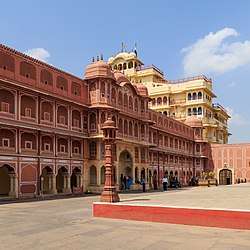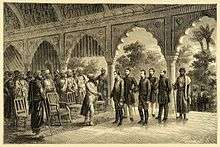Jaipur State
| Kingdom of Jaipur | |||||||
|---|---|---|---|---|---|---|---|
| 1128–1947 | |||||||
 Flag
 Coat of arms
| |||||||
 Jaipur State in the Imperial Gazetteer of India | |||||||
| Capital | Jaipur | ||||||
| Common languages | Dhundari-Marwari-Rajasthani dialect of Hindustani (Hindi-Urdu) and Sanskrit | ||||||
| Government |
Princely state of British India (1818-1947) Monarchy (1128-1818) | ||||||
| Maharaja Sawai | |||||||
• 1128 | Dūlaha Rāya (first) | ||||||
• 1922–1948 | Man Singh II (last) | ||||||
| History | |||||||
• Established | 1128 | ||||||
• Acceded to India | 1947 | ||||||
| Area | |||||||
| 1931 | 40,407 km2 (15,601 sq mi) | ||||||
| Population | |||||||
• 1931 | 2631775 | ||||||
| Currency | Indian Rupee | ||||||
| |||||||
| Today part of | Rajasthan, India | ||||||



Jaipur State was a princely state of India from 1128 to 1947. It was centred on Jaipur town. It existed from the 12th century until Indian Independence in 1947. According to the different periods of history it was also known as Jaipur Kingdom, Amber Kingdom, Dhundhar Kingdom and Kachwaha Kingdom.
History
Jaipur's predecessor state was the Dhundhar (Dausa) kingdom, founded in 1093 by Duleh Rai, also known as Dulha Rao. Jaipur state was known as Amber between the fourteenth century and 1727. In that year, a new capital was built and named Jayapura, then the kingdom was renamed Jaipur.[1]
Amber Kingdom
In 1561, the chief at Amber, Bharmal Kachwaha, sought alliance with Akbar, the Mughal emperor. He was formally recognised as a Raja by the Mughals and was invested into the Mughal nobility in return for his daughter's marriage to Akbar. Raja Bharmal's daughter, Harkha Bai, who married Akbar, later became the mother of the fourth Mughal emperor Jahangir, she gained prestige in Mughal court during Jahangir's reign as the emperor's mother. By this relation, the Rajas of Amer gained significant prominence in the Mughal court.
A governor was appointed to oversee Bharmal's territory and a tribute arrangement saw Bharmal given a salaried rank, paid for from a share of the area's revenue.[2][3]
The ruling dynasty of Amber prospered under Mughal rule and provided the Mughal Empire with some distinguished generals.[4] Among them were Bhagwant Das, Man Singh I, who fought and governed from Kabul to Orissa and Assam and Jai Singh I.[4]
Jaipur Kingdom
Jai Singh was succeeded by Ramsingh I, Bishan Singh and Jai Singh II. Jai Singh II, also known as Sawai Jai Singh, ruled the state from 1699 to 1743 was a famous mathematician and astronomer and during his rule the new capital city of Jaipur was founded[4] in 1727.
Throughout the disintegration of the Mughal Empire, the armies of Jaipur were in a constant state of warfare. Towards the end of the 18th century, the Jats of Bharatpur and the chief of Alwar declared themselves independent from Jaipur and each annexed the eastern portion of Jaipur's territory.[4] This period of Jaipur's history is characterised by internal power-struggles and constant military conflicts with the Marathas, Jats, other Rajput states, as well as the British and the Pindaris (Jaipur's former mercenary allies). Jaipur suffered against the Rathors of Marwar in the Battle of Gangwana with appalling losses.[5] The kingdom again suffered a disastrous defeat at the hands of the Maratha forces of Mahadji Scindia in the Battle of Patan in 1790.[6] Nevertheless enough wealth remained in Jaipur for the patronage of fine temples/palaces, continuity of its courtly traditions and the well-being of its citizens and merchant communities. A treaty was initially made by Maharaja Sawai Jagat Singh and the British under Governor General Marquis Wellesley in 1803, however the treaty was dissolved shortly afterwards by Wellesley's successor, Lord Cornwallis. In this event, Jaipur's Ambassador to Lord Lake observed that This was the first time, since the English government was established in India, that it had been known to make its faith subservient to its convenience.[7]
In 1818 the Jaipur state became a British protectorate. In 1835 there was a serious disturbance in the city, after which the British government intervened.[4] The state later became well-governed and prosperous.[4] During the Indian rebellion of 1857 when the British invoked the treaty to request assistance in the suppression of rebellious sepoys, the Maharaja opted to preserve his treaty, and thus sent in troops to subdue the uprisings[4] in the area around Gurgaon.
Jaipur's last princely ruler signed the accession to the Indian Union on 7 April 1949.
Rulers
Chanda clan of Meena tribe ruled this area till 947 CE. Later the Maharajas of Jaipur belonged to the Kachwaha dynasty.[8]
- Dūlaha Rāya
- Bhau Singh
- Jai Singh I
- Ram Singh I
- Bishan Singh
- 1699 – 21 Sep 1743: Jai Singh II (b. 1688 – d. 1743)
- 1743 – 12 Dec 1750: Ishwari Singh (b. 1721 – d. 1750)
- 1750 – 5 Mar 1768: Madho Singh I (b. 1728 – d. 1768)
- 1768 – 13 Apr 1778: Prithvi Singh II (b. c. 1762 – d. 1778)
- 1778 – 1803: Pratap Singh (b. 1764 – d. 1803)
- 1803 – 21 Nov 1818: Jagat Singh II (b. ... – d. 1818)
- 22 Dec 1818 – 25 Apr 1819: Mohan Singh (regent) (b. c. 1809 – d. ...)
- 25 Apr 1819 – 6 Feb 1835: Jai Singh III (b. 1819 – d. 1835)
- Feb 1835 – 18 Sep 1880: Ram Singh II (b. 1835 – d. 1880)
- 18 Sep 1880 – 7 Sep 1922: Madho Singh II (b. 1861 – d. 1922)
- 7 Sep 1922 – 15 Aug 1947: Sawai Man Singh II (b. 1912 – d. 1970)
- 24 June 1970 – 28 December 1971: Sawai Bhawani Singh (b. 1931 – d. 2011)
Jaipur Residency
The Jaipur Residency was established in 1821. It included the states of Jaipur, Kishangarh and Lawa. The latter had belonged to the Haraoti-Tonk Agency until 1867.[9]
See also
References
- ↑ Princely States of India
- ↑ Wadley, Susan Snow (2004). Raja Nal and the Goddess: The North Indian Epic Dhola in Performance. Indiana University Press. pp. 110–111. ISBN 9780253217240.
- ↑ Sadasivan, Balaji (2011). The Dancing Girl: A History of Early India. Institute of Southeast Asian Studies. pp. 233–234. ISBN 9789814311670.
- 1 2 3 4 5 6 7

- ↑ History of Jaipur by Jadunath Sarkar pg. 209
- ↑ History of Jaipur by Jadunath Sarkar pg. 289
- ↑ Giles Tillotson, Jaipur Nama: Tales from the Pink City.
- ↑ Sarkar, Jadunath (1994). A history of Jaipur : c. 1503-1938 (Rev. ed.). Hyderabad: Orient Longman. ISBN 9788125003335.
- ↑ Imperial Gazetteer of India, v. 16, p. 156.
| Wikimedia Commons has media related to Jaipur State. |